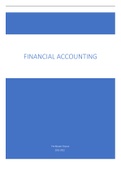Summary
Financial Accounting for Pre-MSc Summary
- Course
- Institution
- Book
In this document you will find a summary of the theory for the course “Financial Accounting for Pre-MSc” taught at the University of Groningen. The summary gives you a good theoretical basis to then make the practice assignments so that you are completely ready for the exam.
[Show more]





